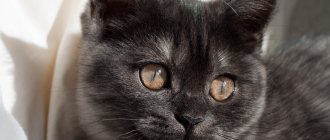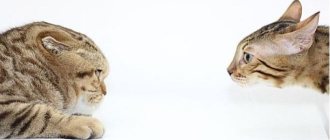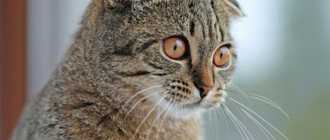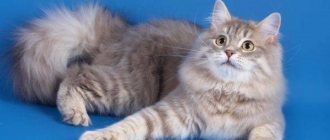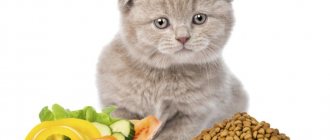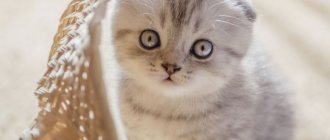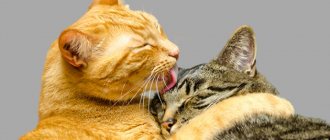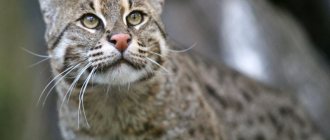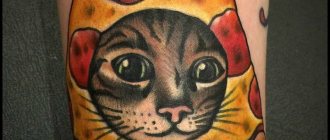Description of the breed, characteristics and behavioral characteristics of the Scottish cat
The breed was first bred in Scotland in the mid-twentieth century. A simple shepherd and his wife adopted a kitten from its mother with floppy ears. At the time, this was considered a flaw, not a feature.
The couple crossed the cat with a regular cat and as a result received several kittens with floppy ears in the litter. This event marked the beginning of the Scottish cat breed.
The uniqueness of the breed is that with proper mating, kittens with straight ears appear - Scottish Straight and fold-eared kittens - Scottish Fold.
Correct mating - one of the partners should have straight ears. The gene responsible for lop ears is transmitted with only a 50% probability. If two partners with floppy ears are crossed, the kittens are born with genetic problems and do not live long.
Scottish kittens and straight in the middle
Newborn kittens are born with straight ears. Starting from the 21st day of life, a fold forms on the ears and only by the end of the first month the ears become recumbent. Therefore, it is impossible to immediately see and guess what kind of kitten it will be.
Scottish cats have a strong body, a wide chest and a strong neck. Paws are of medium height, with wide and neat pads. The head is round with pronounced cheeks and chin. The eyes especially stand out - large, round and bright.
The average life expectancy of such cats is fifteen years.
This charming creature is the closest relative of the British shorthaired purr.
Cats have a calm character, moderately active behavior, and the kittens are smart. They like to lie with their paws tucked under them, and if something interests them, they can stand on their hind legs, which reminds them of a gopher. Scots are friendly and get along well with other pets.
External features
When felinologists develop a new breed of cat, they carefully study and take notes on all the features of the fluffy’s appearance and character. The same thing happened with Scottish Straight cats. Today, there are certain breed standards that should be followed when describing the appearance and developmental characteristics of animals. Scientists have been observing Scottish kittens for more than fifty years, which has helped them identify the following features:
Appearance of a Scottish Straight cat
Scottish Straight cats are of medium size compared to their other relatives and have a slightly rounded, proportional body. As I said a little above, the head of fluffies also has a round shape (which distinguishes them from the British).
Of course, it is obvious that Scottish Straight cats have straight ears. In addition, they have a medium shape and sharp tips.
As for the color of the breed, it can vary and come in many shades. The most common colors are:
- white;
- ginger;
- tabby;
- color point;
- brown;
- grey;
- black;
- blue;
- bicolor
The fur of kittens, like that of adult cats, is quite soft, pleasant to the touch and even a little plush. It is thick and slightly fluffy, which is why animals need to be combed regularly. By the way, today there are two types of Scottish cat breeds – longhaired and shorthaired.
The weight of a Scottish Straight cat varies from 3 to 5 kg. While adult males are slightly larger and can weigh up to 5-6 kg. Weight more than 6 kg is extremely rare. Other external features of cats of this breed include:
- Large round eyes. Eye color ranges from dark brown to amber.
- Stocky build.
- Strong but rather short legs.
- Round paw shape.
- Long, flexible tail, slightly tapering towards the tip.
- High forehead.
- Thick neck.
- Short wide nose.
Characteristics of the Scottish Straight breed
The character of Scottish cats is an important aspect that interests everyone who wants to bring fluffies of this breed into their home. There is nothing special to worry about - Scottish Straight cats have a kind and playful disposition, characteristic of many pets.
Since childhood, the Scottish Straight kitten has been distinguished by its independent character. He doesn’t really like to sit in his arms for a long time and prefers to lie next to a person. In their free time from sleeping and eating, fluffies prefer to explore the territory and play games. Hide glass and other fragile items away if you don't want to pick up shards from the floor. Don't worry about the animal knocking vases off the top shelves - Scottish Straights don't like to climb too high.
Purr's favorite games are hide and seek and, of course, a ball. These kittens live by the principle: the more toys, the better. Therefore, buy them plush mice from time to time if you do not want the cat to play with your gloves or socks.
View this post on Instagram
#goodmorning #catmolly #cat #catgames #findme #catfan #scottishstraight #scottishcat #lovecat #gm #cat #molly
A post shared by Scottish Cat Molly (@instacat.molly) on Nov 26, 2018 at 11:06pm PST
Despite their strong love for their owners, British Straights do not like to impose their company on people. They can easily take care of themselves. When living in a house with several people, kittens tend to become more attached to one person, who gets all their attention. Scottish Straights get along well with children and other pets (except rodents and birds).
By the way, this breed tolerates large companies very well. So, if you often have guests, don’t worry, the kitten will not be afraid of them.
Despite all their independence, Scottish Straight kittens cannot stand being alone for long periods of time. They need at least the physical presence of a person in the apartment. That is, you can just sit and watch TV, but the fluffy will feel safe. If your job requires you to be away from home often, this breed of cat will not suit you.
Who else is not suitable for a Scottish Fold kitten? People with allergies to wool. The animals are quite fluffy and shed heavily when it gets warmer. Therefore, if you have noticed attacks of an allergic reaction in the presence of pets, it is better to adopt a hairless kitten.
Scottish Fold or Scottish Fold
The most popular and famous cat is the Scottish Fold, which is distinguished by folded ears. Some may have several folds.
Features of the British Scottishfold:
- powerful chin and domed high forehead;
- graceful transition from forehead to nose;
- the tail is of medium length and tapers towards the end;
- shiny and soft coat, slightly shorter on the face and paws.
The character of lop-eared representatives is reserved and calm. They quickly get used to new surroundings and conditions.
They find a common language with other animals and children, are moderately active and love to relax.
Scottish lop-eared
The tartan is clean, it is necessary to change the filler and wash the tray on time.
Standard characteristics of Scottish Straight
These cats were called to participate in various competitions not so long ago, and in order to participate, all animals must be selected in accordance with world standards:
- Head – round head shape, with pronounced wide cheekbones and cheeks. Short, massive neck. Short round forehead, straight nose. Smooth, strong chin.
- The eyes are huge, wide-opening, deep-set and widely spaced. Eye color most often matches the external color of the cat.
- The ears are short, wide, with pointed tips, erect.
- The body is large, massive with a broad chest and shoulders.
- The legs are short and powerful.
- The tail is small, dense and wide in girth.
- Wool - the body is covered with fairly dense vegetation, short in length and soft in texture.
Scottish Straight or Straight
A variety of Scotsman is a cat with straight ears - Scottish (straight). In general, the straight-eared ones are similar to their brothers, the lop-eared ones. They have only slight differences, except for the appearance of the ears.
Straights have:
- wide and small nose;
- dense coat with undercoat.
In general, Straits are similar in character to Scottish dogs and have no special differences.
They are also friendly and affectionate and need contact with their owner.
There are:
- long-haired – the wool is of medium length;
- shorthair – dense and plush wool.
Scottish straight cat
Care and feeding of Scottish Straight cats
The process of caring for Scottish Straight kittens lies entirely with the owner. Therefore, it is so important to understand the basic rules and help the fluffy grow into a strong and healthy cat.
Grooming process for your Scottish Straight
Caring for a purr is not particularly difficult. The main thing is to have all the necessary items on hand. Before taking your Scottish kitten home, get:
- tray;
- a bowl for food and water;
- tray filler;
- sleeping place (bed);
- scratching post.
The tray for a cat should be deep, but not so deep that the fluffy has to constantly jump over the sides. The filler must be selected by trial and error. This is the only way you will understand which option is ideal for your pet.
Caring for Scottish Straight kittens primarily concerns the coat. It needs to be brushed regularly. For short-haired purrs, it is enough to repeat the procedure once a week. But with long-haired dogs it is a little more difficult - they need to be combed 3-4 times a week.
Watch the animal's ears and eyes. It is recommended to clean the ears with a cotton pad soaked in water once every 1-2 weeks. Caring for your furball's eyes includes checking for discharge and pustules. The first one can be removed yourself with a cotton pad. But with the second problem, it is better to immediately go to the veterinarian.
With the arrival of warmth comes the period of molting. To help your cat get rid of excess fur, wet your hand with water and pet the animal. This will remove fallen hairs. It is not necessary to bathe the cat. But if you want to give your fluffy a bath day, don’t worry - Scottish Straight kittens do not have a strong fear of water.
If the kitten likes to sharpen its claws on your favorite sofa or new chair, it is better to trim the animal’s nails. Read about how to do this correctly here.
Training Scottish Straight kittens
Since childhood, we Scottish Straights have been particularly smart. Therefore, if you want to train your Scottish kitten to use the litter box or show him where the food bowl is, it won’t take much time or effort. Just follow the regimen recommended by leading veterinarians.
In principle, kittens quickly understand what they can play with, where to sleep, etc. The main thing in the learning process is not to scream or show aggression towards the animal. Otherwise, the fluffy will continue to do what you forbid, simply to spite the owners.
By the way, this breed is very trainable. You can teach your fluffy to give his paw or, for example, to bring his favorite toy. Just take the time to exercise and be sure to reward the kitten for its efforts with something tasty.
Scottish Straight kitten diet
Many furry owners are interested in what to feed their Scottish Straight kitten? In the process of creating an animal’s diet, you should be very careful - cats of this breed have an enviable appetite, which is why they easily gain excess weight.
All veterinarians are inclined to believe that the most optimal type of food for purrs is high-quality premium food. As a rule, such products already contain all the necessary vitamins and microelements, allowing cat owners not to worry about the harmonious growth and development of the cat.
What to feed your Scottish Straight cat if food is not your option? The list of acceptable dishes is quite extensive:
- Lean meat (chicken, rabbit or turkey).
- Sea fish. It is best to give it no more than once a week. Avoid types of fish with a lot of small bones.
- Zucchini, pumpkin.
- Chicken or quail eggs (1-2 times a week).
- Dairy products. Forget about plain milk - it can cause intestinal upset.
The main thing in all this is to maintain a balance of carbohydrates, proteins, fats and vitamins. Be sure to ensure that your cat has constant access to clean drinking water.
Popular colors
The Scotsman has many colors, they are divided into groups:
Basic plain (white, chocolate, smoky, black)
Cats have a uniform color. White color belongs to this group. This color is dominant and when mated to a white cat, the litter will either be completely white or most of the kittens.
Color white
The black cat has fur with a beautiful and uniform color.
Scottish Straight black color
If white fibers are present, the breeders remove them.
An animal with a lilac color has a light gray color with a cold tint
Tabby
Different colored wool forms different patterns.
Scottish fold tabby
Marble
Stand out in this group with marbled colors - light - dark shades form different patterns.
Scottish marbled kitten
Tortoiseshell
Only cats have this color. Cats can have this color due to genetic disorders. Patchwork turtle
(Calico). This is a very rare species among the Scottish Fold cat breed and is a mixture of bicolor and tabby (tortoiseshell) colors.
Tortoiseshell color
Colorful color is found in any color variations, combined with tabby, silver, gold, smoke and white.
Silver, gold and smoky
These cats have a white or golden coat and undercoat. A fairly popular color, Whiskas (striped), is a type of silver tabby. Thanks to participation in advertising campaigns for brands that produce pet products, Scottish kittens with silver colors are very popular among animal connoisseurs.
Silver
Gold and silver
Smoky
Multicolored
Scots with blue eyes and light fur. The color is found in any color variations, combined with tabby, silver, gold, smoke and white, marble, red, cream.
Cream color of the British cat
History of the breed
Its first example was found in the 60s of the 20th century. It was in provincial Scotland, in farming. A wild tabby cat gave birth to a kitten from an unknown father. The baby was named Susie, she had small curled ears.
Over time, she began to give birth to kittens often, so the owners of the farm distributed the babies to their comrades and fellow villagers. And one day such a Scottish Fold ended up with Lady Mary Ross. Tu was intrigued by the animal’s unique exterior.
See also what British fold kittens look like in the photo.
Not being a real felinologist, she, after consulting with professionals, decided to create an unusual breed. For this purpose, she arranged a mating of a fold-eared cat with a British female with short fur. She set up their daughter with a gay British man. And as a result, the first examples of the Scottish Fold breed were born, which had unusual ears. See all photos of Scottish folds.
There is another theory about the appearance of the Scottish Fold. They have been known from it since the 19th century. This fact is clear from the notes of Charles Darwin, in which he describes cats from China with folded ears.
The 70s of the 20th century were marked by a ban on scientists breeding individuals with drooping ears. This was explained by the fact that cats with similar ears have problems removing ticks. In addition, experts found that the furry babies being born could not hear normally.
Having such problems, breeders have done a lot of work to help get rid of them.
Scottish Folds were also banned due to a number of serious illnesses affecting these cats. Some suffered from fusion of spinal discs, others had crooked legs. Genetic specialists again needed to correct the flaws.
During the experiments, they found that animals with curved ears should only be mated with straight-eared individuals. The result of this approach was fluffy babies with curled ears (Scottish Fold) and with protruding ears (Scottish Straight).
Maintenance and care
In general, Scots don't require much grooming.
Everything is as usual:
- it is necessary to monitor the general condition of the animal;
- comb it a couple of times a week, preferably using a special lotion;
- bathe your pets several times a month;
- Once a week, check the cleanliness of your ears and remove dirt;
- be sure to clean your eyes, the vulnerable spot is the corners, dirt often accumulates here;
- shed periodically, especially in autumn and spring;
- It is advisable to purchase a tray that is deeper;
- walk your pets. Scots need fresh air.
Cats definitely need to get up-to-date vaccinations!
Scottish cats are naturally endowed with good health.
Temperament and character of the cat
A cat of this breed is perfect for a large family. They love communication and quickly find a common language with children. The Scots are very affectionate and friendly. Undoubtedly, these are the advantages of the breed.
The disadvantages include the fact that cats tolerate loneliness very hard.
But this can be corrected if you get a friend - a dog or a second cat. In general, Scots get along well with all animals.
Scots can be considered ideal family animals
Features of character and behavior
By nature, Scots are patient cats. Animals do not show aggression unless necessary, and are moderately loyal to children. The Scottish cat is more kind-hearted than touchy by nature, so he allows himself to be stroked and takes education well.
Such a characteristic of the breed as curiosity, on the one hand, deprives the pet of cowardice, and on the other, forces it to go where it shouldn’t. However, the absence of vindictiveness and mischief softens the behavior of the Scottish cat. The animal is not offended, quickly opens up to the owner and becomes attached to him. In addition, the pet calmly tolerates short-term loneliness, and meows mainly for business.
The Scottish cat gets along with other animals, but does not like territorial conflicts, preferring to avoid contact. At the same time, the character of the breed cannot be called flexible; the pet can be restive, capricious and demonstratively attract attention to itself.
The description of the Scottish cat breed calls them active, but everything is relative. The animal will not turn over furniture, hang on curtains or run without a reason. But he will happily play with his owner or small objects.
Nutrition
You can feed such pets with natural food, industrial food, or a mix of both types. Features of each type:
- The most beneficial is eating from natural products. You can include in your diet: lean meats, fish products, cereals and boiled vegetables.
- It is advisable to use premium-class ready-made feed. One of the most common is Royal Canin.
- A mixed diet is more varied, but it complicates the digestive processes.
The diet depends on the age of the animal.
Kittens up to four months old are fed about six times a day.
The nutrition of a Scottish Fold kitten is based on a combination of natural food and food
From four months to a year, they are transferred to four meals a day, and starting from a year, they can be fed twice a day.
Cost of a kitten
What is the price. The price of Scottish cats starts from 4,000 rubles from private owners. In the nursery and with documents - the price is from 10,000 rubles and above. The price is affected by pedigree, color and titles, if any.
When buying a kitten you need to pay attention to:
- on the general appearance of the animal;
- condition of eyes, ears;
- the fur should shine;
- kitten activity;
- vaccination;
- sterilization;
- pedigree and passport of the animal.
Of course, it is best to purchase a kitten from specialized nurseries or from trusted breeders.
Buy a vaccinated and sterilized Scot, this is the key to future health.
If you are purchasing a titled animal or for exhibitions, you will need a pedigree, which will be provided by the seller.
The most prized cats are solid colors - white, black, blue and chocolate. No inclusions or stains.
The price depends on the purity of the animal's breed
There are quite a lot of nurseries in Russia, some of the famous ones are:
- MOY LUBOV, Kashira (MO).
- NATAVELLA, Moscow.
- PANTHEON, Zhukovsky.
- PFILLIS, Zelenograd.
- ALCASAR, St. Petersburg.
- ALISON BRAND, Kostroma.
Features of the Scottish Shorthair breed
Their harmoniously built figure has medium-sized dimensions. The body is cylindrical, the width of the shoulders and pelvis are the same. The body is dense and well muscled, supported by relatively short and strong limbs. This stocky build does not prevent them from moving easily, freely and gracefully. When walking and running, an elongated, energetic tail plays an important role.
The shape of the Scottish Straight's skull is spherical, the forehead is protruding, the cheeks are plump, the chin is strong-willed and massive.
The ears are straight, stand upright at a great distance from each other at the top of the head, their ends point in different directions. They give the head of the Scottish Straight a special charm.
The eyes are large, round, and widely set, which gives their owners such a pretty expression. Their colors are in harmony with the color of the fur.
The coat of the Scottish Straight cat breed is characterized by thick and silky hairs. It is of medium length, the fur is not pressed against the body, the undercoat densely covers the surface of the body.
The breed has a wide choice of colors, which allows anyone interested to find a fluffy with the desired color.
They are as follows:
- fiery;
- cocoa color;
- black;
- blue;
- lilac (not often, its price is much higher);
- marble, which is also called “whiskas”;
- white;
- light brown or cream;
- tricolor, otherwise tortoiseshell.
This variety of colors can suit the tastes of both adult owners and children who choose a Scottish Straight kitten.
Scottish health characteristics and vaccination
In general, the breed has excellent health. Diseases of the breed include osteochondrodystrophy - skeletal curvature. This does not occur often and only in fold-eared cats. Also, these Scots have a weak spot – their ears. It is important to clean them on time.
With the right diet and proper care, regular vaccinations, a representative of this breed will live a long time.
Required vaccinations:
- Panleukopenia.
- Calicivirus.
- Rhinotracheitis.
Recommended:
- Chlamydia.
- Leukemia.
- Rabies.
There are often long-livers among Scots
How to name a boy and girl kitten
You have become the proud owner of a cat and now you need to name it. Let's look at female and male cat names. List of common names and nicknames for Scottish Fold cats and male kittens.
The most common nicknames for boys:
- Aron.
- Achi.
- Baron.
- Quentin.
- Ludwig.
- Samurai.
- Chaid.
For girls:
- Aina.
- Aura.
- Bastin.
- Gabriel.
- Kara.
- Laffey.
Even the strictest and most serious nicknames turn into beautiful diminutive nicknames
